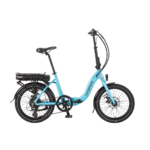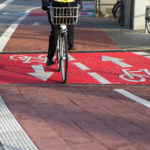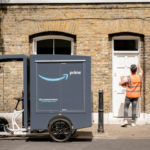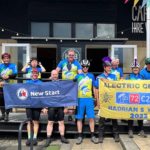more power needed
- Thread starter a415
- Start date
It depends on the petrol motor. From memory, 49 cc motors typically develop between 2.5 hp and 4.5 hp.
Each horse power is 746 watts.
Therefore you won't be able to get an e-bike motor with an output to match those. UK legal motors rank up to 700 watts at most, but there's the odd illegal motor of 1000 watts or so, and one heinzmann model of 2000 watts peak power, though I doubt it could sustain that.
However, bikes roll freely and are light, so depending on rider weight 700 watts gives quite good hill climbing, and 1000 watts can be plenty.
.
Each horse power is 746 watts.
Therefore you won't be able to get an e-bike motor with an output to match those. UK legal motors rank up to 700 watts at most, but there's the odd illegal motor of 1000 watts or so, and one heinzmann model of 2000 watts peak power, though I doubt it could sustain that.
However, bikes roll freely and are light, so depending on rider weight 700 watts gives quite good hill climbing, and 1000 watts can be plenty.
.
Hi a415,
Maybe try mr-motorvator but I think you may need an electric moped/ scooter rather than a peddle assist bicycle as these are designed as an electric powered form of transport rather than electrically assisted.
Still in my early days of pedal assisted cycling and the power assist came as a bit of a shock as was used to motor bikes and was, initially, disappointed by the amount of power from the motor.
I am now in the frame of mind that I have a peddled bicycle that has a bit of an electric boost for the exhausting bits rather than I have an electric motorcycle that I can assist if need be. Steep learning curve for me!
Maybe try mr-motorvator but I think you may need an electric moped/ scooter rather than a peddle assist bicycle as these are designed as an electric powered form of transport rather than electrically assisted.
Still in my early days of pedal assisted cycling and the power assist came as a bit of a shock as was used to motor bikes and was, initially, disappointed by the amount of power from the motor.
I am now in the frame of mind that I have a peddled bicycle that has a bit of an electric boost for the exhausting bits rather than I have an electric motorcycle that I can assist if need be. Steep learning curve for me!
An electric scooter
This might be more what you are looking for Electric Bike Sales - Shop Online for Electric Bikes, Electric Vehicles and Cycle Accessories - EMAX
This might be more what you are looking for Electric Bike Sales - Shop Online for Electric Bikes, Electric Vehicles and Cycle Accessories - EMAX
Although I agree with Flecc's summary of moped power output, you don't need as mush power from an electric motor to get the same performance. A moped engine cannot deliver significant torque at low rpm, so suffers on hills, even with a gearbox or CV transmission.
On the other hand, an electric motor gives maximum torque at zero rpm, with torque falling off with rpm. This means that a relatively low hp electric motor will "feel" much more powerful than it's equivalent power petrol engine, particularly at low speeds.
I have experience with a smaller Crystalyte hub motor in a 20" wheel. It provides more torque then the tyre can cope with at low speeds, opening the throttle full caused wheel spin. In my set-up I was delivering just over 1000 watts (about 1.4 hp) to this motor, but this gave a torque figure from a standing start (full throttle) of about 55 N-m, much more than that available at a moped back wheel for a standing start.
The bigger 5XXX series Crystalyte hub motors are easily capable of handling sustained power levels of over 2000 watts. Many of the high-power enthusiasts on the Endless Sphere forum have been running them at voltages around 72V or more, with controllers modified to handle at least 50 amps, indicating that they will take peak power levels of 3500 watts without damage.
Such power levels are not only illegal for road use in the UK as a bicycle, but require a great deal of care and attention to the rest of the bike as well to be safe. Sustained speeds of over 40 mph with such a set up are fairly easy to achieve, which means good brakes and a robust frame.
Bear in mind that an average cyclist will struggle to deliver more than a couple of hundred watts or so for any length of time. Adding even a motor like my old 405 is like having five or six pairs of legs trying to push virtually the same weight bike and is certainly a greater power than would be available from even the best cyclist in the world, I suspect.
Jeremy
On the other hand, an electric motor gives maximum torque at zero rpm, with torque falling off with rpm. This means that a relatively low hp electric motor will "feel" much more powerful than it's equivalent power petrol engine, particularly at low speeds.
I have experience with a smaller Crystalyte hub motor in a 20" wheel. It provides more torque then the tyre can cope with at low speeds, opening the throttle full caused wheel spin. In my set-up I was delivering just over 1000 watts (about 1.4 hp) to this motor, but this gave a torque figure from a standing start (full throttle) of about 55 N-m, much more than that available at a moped back wheel for a standing start.
The bigger 5XXX series Crystalyte hub motors are easily capable of handling sustained power levels of over 2000 watts. Many of the high-power enthusiasts on the Endless Sphere forum have been running them at voltages around 72V or more, with controllers modified to handle at least 50 amps, indicating that they will take peak power levels of 3500 watts without damage.
Such power levels are not only illegal for road use in the UK as a bicycle, but require a great deal of care and attention to the rest of the bike as well to be safe. Sustained speeds of over 40 mph with such a set up are fairly easy to achieve, which means good brakes and a robust frame.
Bear in mind that an average cyclist will struggle to deliver more than a couple of hundred watts or so for any length of time. Adding even a motor like my old 405 is like having five or six pairs of legs trying to push virtually the same weight bike and is certainly a greater power than would be available from even the best cyclist in the world, I suspect.
Jeremy
May or may not be any use but what about one of these electric bikes?
They have Offroad speed switch, (Make it go up to 30mph for offroad use.)
Need flash to view page.
fun2ride.co.uk - Wellcome to the UK's biggest importer of fun - Electric bike, Quad bike, Petrol scooter, Go kart, Come Along Enjoy The Fun
.
PS: Not sure if they are legal on UK roads - I should check before you buy.
.
They have Offroad speed switch, (Make it go up to 30mph for offroad use.)
Need flash to view page.
fun2ride.co.uk - Wellcome to the UK's biggest importer of fun - Electric bike, Quad bike, Petrol scooter, Go kart, Come Along Enjoy The Fun
.
PS: Not sure if they are legal on UK roads - I should check before you buy.
.
Last edited:
Although I agree with Flecc's summary of moped power output, you don't need as mush power from an electric motor to get the same performance. A moped engine cannot deliver significant torque at low rpm, so suffers on hills, even with a gearbox or CV transmission.
On the other hand, an electric motor gives maximum torque at zero rpm, with torque falling off with rpm. This means that a relatively low hp electric motor will "feel" much more powerful than it's equivalent power petrol engine, particularly at low speeds.
I have experience with a smaller Crystalyte hub motor in a 20" wheel. It provides more torque then the tyre can cope with at low speeds, opening the throttle full caused wheel spin. In my set-up I was delivering just over 1000 watts (about 1.4 hp) to this motor, but this gave a torque figure from a standing start (full throttle) of about 55 N-m, much more than that available at a moped back wheel for a standing start.
The bigger 5XXX series Crystalyte hub motors are easily capable of handling sustained power levels of over 2000 watts. Many of the high-power enthusiasts on the Endless Sphere forum have been running them at voltages around 72V or more, with controllers modified to handle at least 50 amps, indicating that they will take peak power levels of 3500 watts without damage.
Such power levels are not only illegal for road use in the UK as a bicycle, but require a great deal of care and attention to the rest of the bike as well to be safe. Sustained speeds of over 40 mph with such a set up are fairly easy to achieve, which means good brakes and a robust frame.
Bear in mind that an average cyclist will struggle to deliver more than a couple of hundred watts or so for any length of time. Adding even a motor like my old 405 is like having five or six pairs of legs trying to push virtually the same weight bike and is certainly a greater power than would be available from even the best cyclist in the world, I suspect.
Jeremy
Hello All
Just to let you know, a British road legal 200w motor of 50N-m does exist. It is a Heinzmann model and available from Emotive Control Systems on 01642 713023 (emotivecontrolsystems.co.uk). They also have a 53N-m 250w version too (European spec).
These are very torquey motors, so if you were to use them, you'll need to ensure that your frame is very robust to avoid things like flex on take off and that you have adequately upgraded brakes.
Hope this helps
Hi a415,
Bikes like your currie electro drive izip used to be among the most powerful hill climbers (though the high bike weight doesn't help), so maybe there is something negatively affecting performance of your bike, like low battery voltage? Or perhaps your hills are just too steep for it, even with pedal assist - tell us how steep are the hills & we can advise better what might work in terms of power .
.
I know that some people have souped up similar bikes (look for 'currie mongoose' I think it is the same bike) though mainly for speed, not torque, so that would't help on hills, but I'd ensure the bike is performing as it should first and even then I'd be inclined to follow flecc's advice to
 hope that helps? Let us know how you get on, or more about your hills if you want more help with that
hope that helps? Let us know how you get on, or more about your hills if you want more help with that  .
.
Stuart.
Bikes like your currie electro drive izip used to be among the most powerful hill climbers (though the high bike weight doesn't help), so maybe there is something negatively affecting performance of your bike, like low battery voltage? Or perhaps your hills are just too steep for it, even with pedal assist - tell us how steep are the hills & we can advise better what might work in terms of power
I know that some people have souped up similar bikes (look for 'currie mongoose' I think it is the same bike) though mainly for speed, not torque, so that would't help on hills, but I'd ensure the bike is performing as it should first and even then I'd be inclined to follow flecc's advice to
flecc said:"enjoy it as it is and not spend money on what is essentially a basic old design electric bike. Better to get the maximum pleasure for it's life as it's a reasonable performer and save your money for an upgrade to a more expensive and more capable modern bike at some future date".
Stuart.
Last edited:
You don't need any high-tech kit!
Two methods:
1. Get a long piece of wood, a spirit level and a tape measure - and get measuring the fall over the known length of your wood. divide one by the other and you will have a near approximation of your steepness
2. Look at an ordnance survey map, count the contours and measure the distance, and divide one by the other
Two methods:
1. Get a long piece of wood, a spirit level and a tape measure - and get measuring the fall over the known length of your wood. divide one by the other and you will have a near approximation of your steepness
2. Look at an ordnance survey map, count the contours and measure the distance, and divide one by the other
thanks for replies. how can i measure the steepness of hills? i don't want to get a GPS or anything expensive
well its quite a distance for me to carry a long piece of wood, a spirit level and a tape measure to, when i am on the bike. is there an online ordnance survey map i don't want to buy one. but i do have a protractor. i presume steepness is measured in degrees from horizontal? or is it 1 in 10 type thing like you see on road signs?
i can guess that the angle of the hill i am trying to get up is about 35degrees from horizontal
i can guess that the angle of the hill i am trying to get up is about 35degrees from horizontal
Flecc has described exactly how to measure steepness of hills, very simple method really, mine is easier...if im exhausted..ITS HILLY.. ..check out his website or past posts you will see how he measure..
..check out his website or past posts you will see how he measure..
ok i wll checkFlecc has described exactly how to measure steepness of hills, very simple method really, mine is easier...if im exhausted..ITS HILLY....check out his website or past posts you will see how he measure..
Unlikely... that's a 70% Grade.i can guess that the angle of the hill i am trying to get up is about 35degrees from horizontal
Attempting to judge the angle of a gradient by eye can be very deceptive and a protractor is only of use if used in conjunction with a level reference.i can guess that the angle of the hill i am trying to get up is about 35degrees from horizontal
In reality no hill on a public road is likely to be as steep as 35 deg from horizontal as that equates to 1 in 1.7 or 57% which is far beyond the capability of virtually any normal motor vehicle to climb and indeed beyond the capability of most pedestrians. As a guide the following are angles from the horizontal and their equivalent gradients.
2 deg = approx 3.5% or 1in 28 which is certainly noticeable.
5 deg = approx 9% or 1 in 11 Quite steep
10 deg = 17% or 1 in 6
15 deg = 24% or 1 in 4 or Very Steep
20 deg = approx 34% or 1 in 3 which is about the steepest ever likely to be encountered.
The famous funicular railway linking Lynton and Lynmouth in Devon has a maximum incline of 56% or 1 in 1.78 or 34 degrees, it looks like this!
For anyone serious about surveying there are cheap laser levels which would make an accurate survey of your local hill a piece of cake.
Related Articles
-
 MTF Enterprises announces acquisition of EMU Electric Bikes
MTF Enterprises announces acquisition of EMU Electric Bikes- Started by: Pedelecs
-
 Wisper 806T folding bike wins Which? ‘Best Buy’
Wisper 806T folding bike wins Which? ‘Best Buy’- Started by: Pedelecs
-
 Sustrans calls for protected cycle lanes
Sustrans calls for protected cycle lanes- Started by: Pedelecs
-
 Amazon launch their first UK e-cargo micromobility hub
Amazon launch their first UK e-cargo micromobility hub- Started by: Pedelecs


